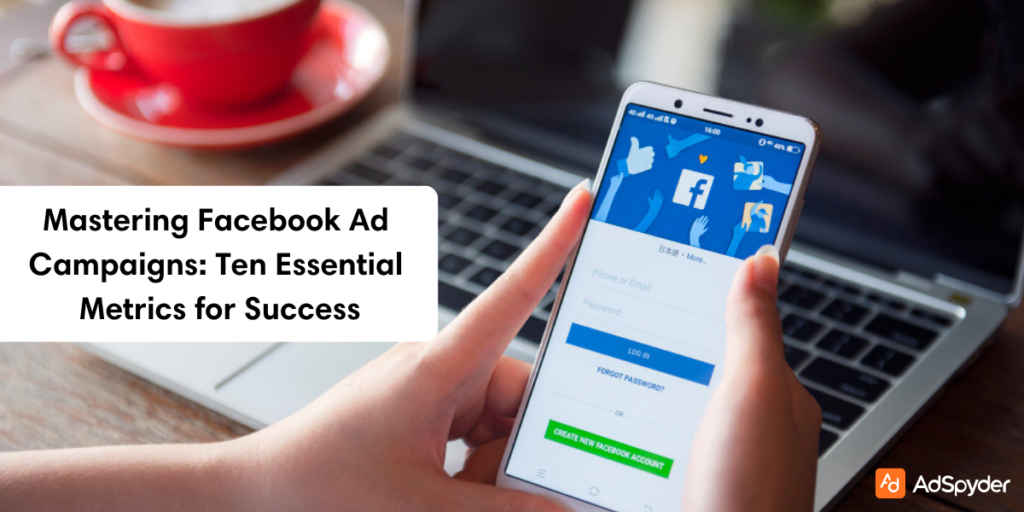Trying to get your Facebook ads to perform better can feel like a puzzle. Understanding and tracking Facebook ad campaign metrics is crucial for optimizing your advertising efforts and maximizing ROI. One key fact is that knowing which metrics matter makes a big difference. Key metrics such as Click-Through Rate (CTR), Conversion Rate, Cost Per Click (CPC), Return on Ad Spend (ROAS), and Frequency provide valuable insights into your campaign’s performance. By analyzing these metrics, you can make data-driven decisions to refine your strategies, allocate budgets more effectively, and achieve better results. This blog delves into the essential Facebook ad campaign metrics you need to monitor for successful advertising in 2024.
Ready to Elevate your Marketing Strategy?
Navigating Facebook Ad Metrics: A Comprehensive Guide

Mastering Facebook Ad metrics sets you on the path to success. Learn which ones match your goals and why they matter for building effective campaigns.
Understanding the Importance of Facebook Advertising Metrics
Facebook advertising metrics are essential for evaluating the performance of your ads. They help identify what works and what doesn’t in your campaigns, allowing you to track success in real-time and adjust strategies to improve results.
Key Points:
- Click-Through Rate (CTR): Measures how many people click on your ad, indicating its effectiveness.
- Cost Per Action (CPA): Tracks the cost of each desired action, helping you manage your budget efficiently.
- Impressions: Counts how often people see your ad, showing its reach and visibility.
- Informed Decisions: Use insights from these metrics to optimize future campaigns, focusing on high-performing ads.
- Efficient Spending: By targeting ads that yield more clicks or lower costs, you ensure your marketing budget is used wisely.
- Achieving Marketing Goals: Monitoring these metrics closely sets you up for success in digital marketing, making every dollar spent on social media campaigns count towards your goals.
Aligning Metrics with Your Marketing Goals
- To make sure your Facebook ads hit their mark, aligning metrics with your marketing goals is key.
- Start by identifying what success looks like for you. Is it more sales, website visits, or brand awareness? Once you know your aim, pick the right metrics to track progress.
- For sales goals, focus on conversion rate and cost per action (CPA). If brand awareness is your target, look at impressions and reach.
- Each metric offers insights into how well your campaigns match up with your objectives.
Click-Through Rate (CTR) in Facebook Ads

Click-Through Rate (CTR) tells you how often people click your ad after seeing it. High CTR means your ads are effective and grabbing attention.
Significance of CTR in Measuring Ad Effectiveness
CTR, or Click-Through Rate, indicates how often people click on your ads after viewing them.
- This metric is crucial for understanding if your ad captures attention and is relevant to viewers.
- A high CTR suggests that your audience finds the ads appealing and worth exploring, signifying strong ad performance.
- By improving CTR, you can achieve better campaign results at a lower cost, ensuring you are targeting the right audience with content they want to see.
Focusing on enhancing CTR ensures more ideal customers engage with your ads, moving them closer to actions like purchasing or signing up.
Key Points:
- Definition and Importance: CTR shows how often people click on your ads after seeing them.
- Indicator of Relevance: A high CTR means your audience finds the ads appealing and relevant.
- Measure of Connection: This metric evaluates how well your message connects with potential customers.
- Campaign Efficiency: Improving CTR can lead to better results at a lower cost, indicating effective targeting.
- Customer Engagement: Enhancing CTR ensures more ideal customers engage with your ads, moving them closer to taking action.
Strategies to Enhance CTR on Facebook
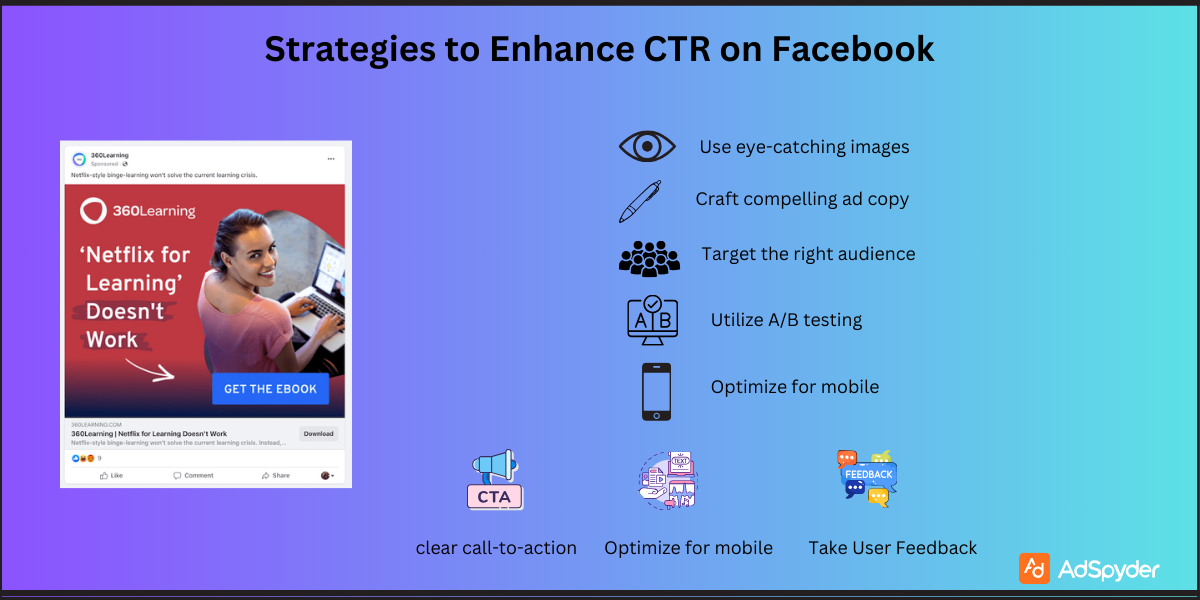
Maximizing the Click Through Rate (CTR) in Facebook is important if you want to enhance your ad campaign. A high click through rate means that more people are interacting with your ads. Therefore the probability of the ads getting clicked and leading to the intended action is high. Here are strategies to help you improve your CTR:
Key Points:
- Use eye-catching images: Clear and bright images work to grab the attention of the people within the shortest time possible.
- Craft compelling ad copy: Keep it brief and highlight the benefits that the audience will get when they join the program.
- Target the right audience: In order to increase its chances of success, it is recommended that advertising be targeted to the audience.
- Test different ad formats: Try carousel, video or single image ads, and see which one will suit you best.
- Optimize for mobile: Facebook is used mostly through mobile devices and this has influenced the development of new features.
- Include a clear call-to-action (CTA): Make sure to specify the action you want a user to take, and make it clear.
- Utilize A/B testing: Examine your ads and identify what factors of your ads work well so that you can replicate them.
Cost Per Acquisition (CPA) on Facebook

Cost Per Acquisition (CPA) on Facebook shows how much you spend to get a new customer. Lowering your CPA helps you save money in your ad campaigns.
Analyzing CPA for Budget Efficiency
- Checking the CPA, or Cost Per Acquisition, helps you understand how much you’re spending to get a new customer. Aim for a low CPA to make sure your Facebook ad budget goes further.
- Watch this closely and adjust your campaigns if the cost gets too high.
- Use data from past ads to find ways to lower your CPA. This might mean changing who sees your ads or improving your ad’s message.
- Lowering the CPA can lead to more success with the same budget, giving you better results for less money spent.
Tips for Reducing CPA in Facebook Campaigns
Having seen how to analyze CPA for budget efficiency, it’s time to know the strategies you can implement to minimize this cost in your Facebook campaigns. Reducing the CPA means that you are getting more ‘bang’ for your money spent on advertising. Here are practical steps to achieve this goal: Here are practical steps to achieve this goal:
- Target the Right Audience: The use of specific parameters on Facebook to target likely customers in a given product or service. This increases conversion chances.
- Optimize Ad Creatives: Make sure your ads make the right impression with great images and persuasive text. Try out a few different versions to determine which one is most effective.
- Use Relevant Landing Pages: Link your ads to landing pages that are most relevant to your ads to help the consumers make informed decisions. This consistency enhances user experience and conversion rates in an application or website.
- Implement A/B Testing: It is recommended to test the various parts of your ads and campaigns like images, headlines, and CTAs, on a regular basis. This means that the organization should retain the strategies that have a positive impact and eliminate the ones that have negative effects.
Tips to Apply Facebook Ads Optimisation Strategies
After you have setup Facebook ad campaigns, check out these tips to optimise for reducing CPA:
- Adjust Bidding Strategy: Try out the different bidding strategies for the Facebook ad platform; the regular bidding or the cost-cap bidding to determine the best one for your objective.
- Monitor Frequency: Observe how many times the ad is displayed to the public. This can be a problem if the ad is displayed too often that people get annoyed, or if it is displayed too few it does not leave any impression at all.
- Enhance Ad Relevance Score: Increase ad appeal and interest to the target consumer, which reduces costs since ads are more likely to be more relevant to the target consumer.
- Utilize Retargeting Campaigns: Target people who have interacted with your product before, for example, those who browsed through your website or used your product but did not purchase it at that time as they are more likely to do so than first-time users. You can use omni-channel marketing strategies to approach these audiences for enhanced conversions.
- Cut Underperforming Ads Early: Monitor the results of ads and cease using ad platforms that do not bring a positive ROI as soon as possible.
- Refine Campaign Objectives: When it comes to choosing the objectives for your campaign, always ensure they are as close to your ultimate goals as possible; whether it is to improve on the conversion rate, generate leads or traffic.
These strategies help ensure that every dollar spent on Facebook advertising works harder towards achieving your marketing goals while keeping costs down.
Engagement Rate: The Pulse of Audience Interaction
Engagement Rate shows how much people interact with your ads. It helps to understand if your content connects well with your audience.
Understanding and Calculating Engagement Rate
- To know how well your Facebook ads connect with people, look at the engagement rate. This measures likes, shares, comments, and clicks your ad gets over total impressions.
- To find it, you take these interactions and divide by impressions or reach, then multiply by 100 to get a percentage.
- A higher percentage means more people found your content worth interacting with.
- Making this number go up can make your campaigns work better. It shows that not only do folks see your ads but they also care enough to react or say something about them. High engagement rates often lead to better campaign performance overall.
Improving Engagement for Better Campaign Performance
You want your Facebook ad campaigns to hit the mark every time. Boosting engagement is key to achieving this goal. It also means that ads are being shown to those viewers who are looking for the offerings from the ads. Here’s how you can make it happen:
- Use eye-catching images: Bright and relevant photos grab attention faster than text. These visually appealing ad copies also increase brand recall.
- Craft compelling headlines: Make sure your headlines are clear, intriguing, and related to your audience’s interests.
- Include calls-to-action (CTAs): Direct viewers on what to do next with strong CTAs like “Shop Now” or “Sign Up”.
- Target the right audience: Define your audience based on their interests, behaviors, and demographics for more personalized ads.
- Test different ad formats: Experiment with various formats such as carousel ads, videos, or stories to see what works best.
- Create interactive content: Polls or quizzes in ads can increase engagement by encouraging participation.
- Optimize for mobile: Ensure your ads look great on mobile devices since most users scroll Facebook on their phones.
- Engage with comments: Reply to comments on your ads to show that you value user feedback and encourage more interaction.
- Schedule posts wisely: Publish your ads when your target audience is most likely online for increased visibility.
These steps can elevate the performance of your Facebook campaigns by strengthening user engagement.
Cost Per Impression (CPI) Insights
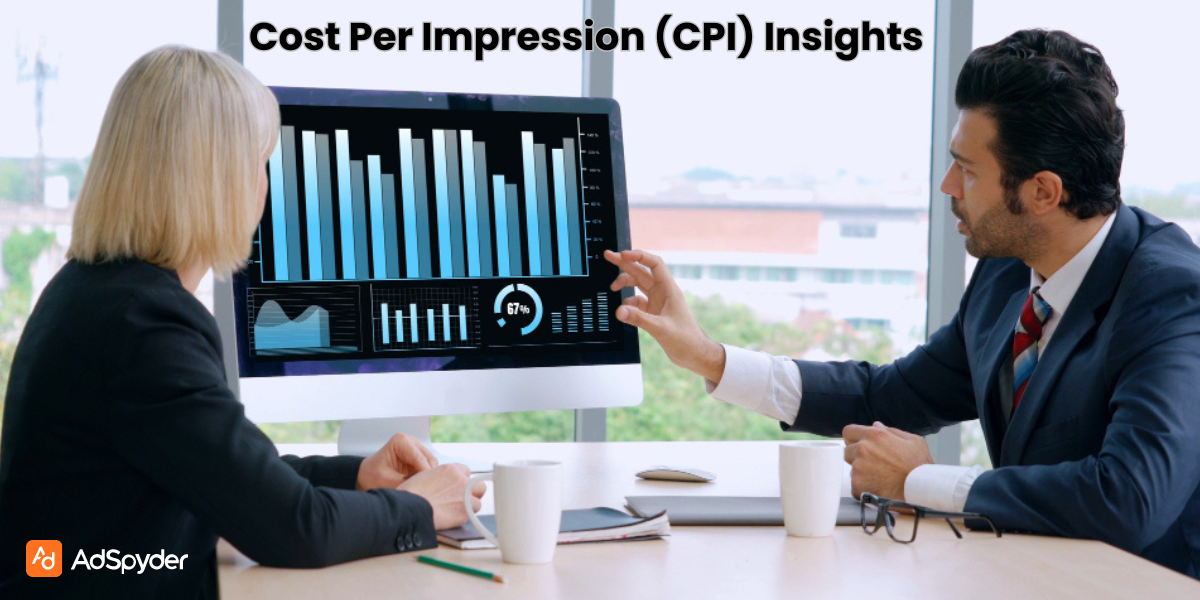
Cost Per Impression (CPI) helps you see how much your ads are costing for every view. Keep an eye on CPI to manage your budget and reach more people.
Evaluating Campaign Reach with CPI
- You need to pay attention to CPI to see how far your ads go. This means looking at how much you spend for each time your ad is shown 1,000 times. It helps you understand if your money is putting your ads in front of enough people. This is critical for paid growth marketing efforts where you are focused solely on acquiring customers.
- A low CPI tells you that lots of people see your ad without spending a lot.
- Keeping track of changes in CPI will also show if your ad reach is getting better or worse over time. If the cost goes up, fewer people are seeing your ads for the same amount of money.
- This could mean it’s time to change something about how you advertise on Facebook.
Balancing Reach and Budget with Effective CPI Management
Managing your Cost Per Impression (CPI) effectively means getting your ads in front of as many eyes as possible without overspending. This balance is key to maximizing the impact of your Facebook advertising campaigns. Here’s how you can achieve it:
- Set clear goals for each campaign. Know what you want to achieve, such as increasing brand awareness or driving sales.
- Understand your audience. Use Facebook’s Audience Insights to figure out who is most likely to be interested in what you’re offering.
- Optimize ad design. Create visually appealing ads that speak directly to your target audience’s interests.
- Test different ad formats. Some formats may result in a lower CPI by attracting more attention and engagement.
- Use targeted targeting options. Narrow down your audience to those most likely to respond, which can reduce waste and lower costs.
- Adjust bidding strategies based on performance data. If certain ads perform better, allocate more budget towards them.
- Monitor ad performance regularly. Keep an eye on how ads are doing and make adjustments as needed.
- Experiment with ad scheduling. Run ads at times when your target audience is most active on Facebook for higher visibility.
- Focus on high – quality content that engages users, leading them to interact with your ad rather than scrolling past it.
- Control frequency to prevent ad fatigue among your audience, which can increase CPI if viewers see the same ad too often without engaging.
Moving onto the significance of analyzing Facebook Ad Impressions will further enhance our understanding of overall campaign reach and effectiveness.
Analyzing Facebook Ad Impressions
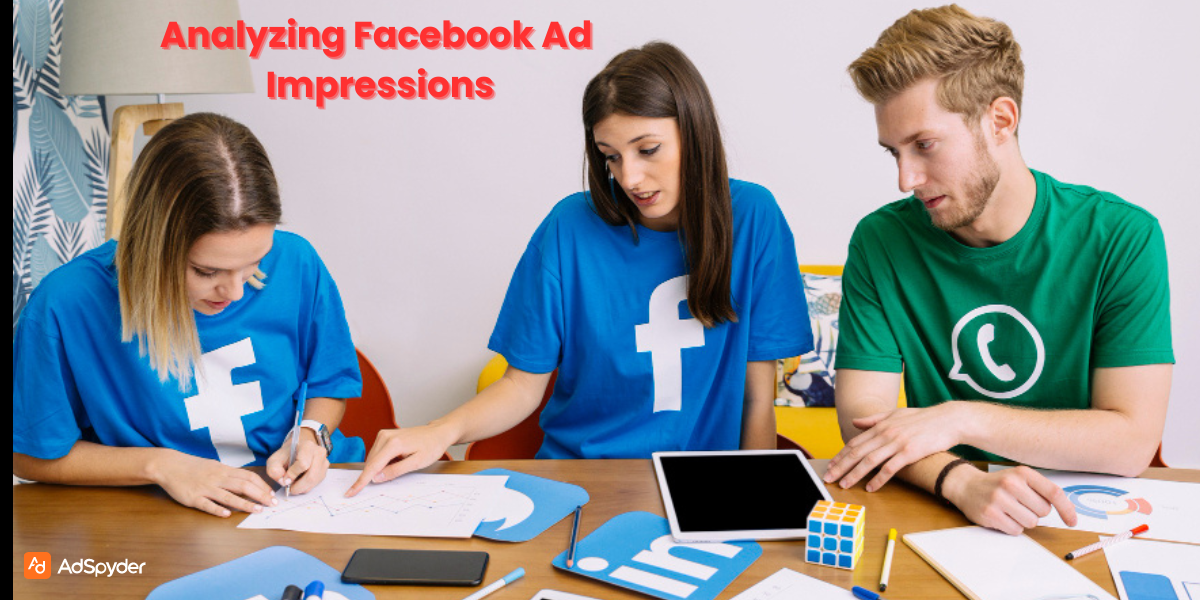
Ad impressions tell you how often people see your ads. Knowing this helps you understand ad visibility better.
The Role of Impressions in Ad Visibility
- Impressions count every time your ad pops up on someone’s screen. This metric shows how often your ad is seen, making it a clear indicator of its visibility.
- High impressions mean more eyes are looking at what you offer, which can lead to greater brand awareness and recall.
- Understanding the role of impressions helps you gauge the reach of your campaigns across Facebook.
- It tells you if your ads have the potential to catch attention in crowded feeds.
- More importantly, tracking impressions guides you in optimizing for better ad placement and timing, ensuring your message stands out more effectively.
Maximizing Exposure Through Optimized Impressions
After understanding the role of impressions in ad visibility, it’s crucial to focus on how to maximize exposure. This involves optimizing your impressions to ensure your Facebook ads reach more people effectively and efficiently. By showing ads to only thise who are looking for the offerings of your brand, you reduce your ad spends.
- Target the right audience: Choose demographics, interests, and behaviors that closely match your ideal customer profile.
- Use eye-catching visuals: Create ads with high-quality images or videos to grab attention quickly.
- Write compelling ad copy: Keep your messages clear, concise, and geared towards prompting action from viewers.
- Optimize for mobile: Design your ads with mobile users in mind since most Facebook users access the platform via mobile devices.
- Test ad placements: Experiment with different ad placements (news feed, stories, right column) to find where your ads perform best.
- Adjust bidding strategy: Use automatic bidding to allow Facebook to optimize your bid amount for maximum exposure at the lowest cost.
- Monitor frequency: Keep an eye on how often people see your ad to avoid ad fatigue and ensure fresh impressions.
- Schedule ads strategically: Post during peak times when your target audience is most active on Facebook for higher visibility.
- Leverage retargeting: Show ads to people who have already interacted with your brand online to increase the chances of conversion.
- Analyze and adjust regularly: Review ad performance data regularly and make necessary adjustments to improve exposure over time.
Check this: Navigating the Future: Emerging Trends in Real Estate Digital Advertising
Conversion Rate for Facebook Ads
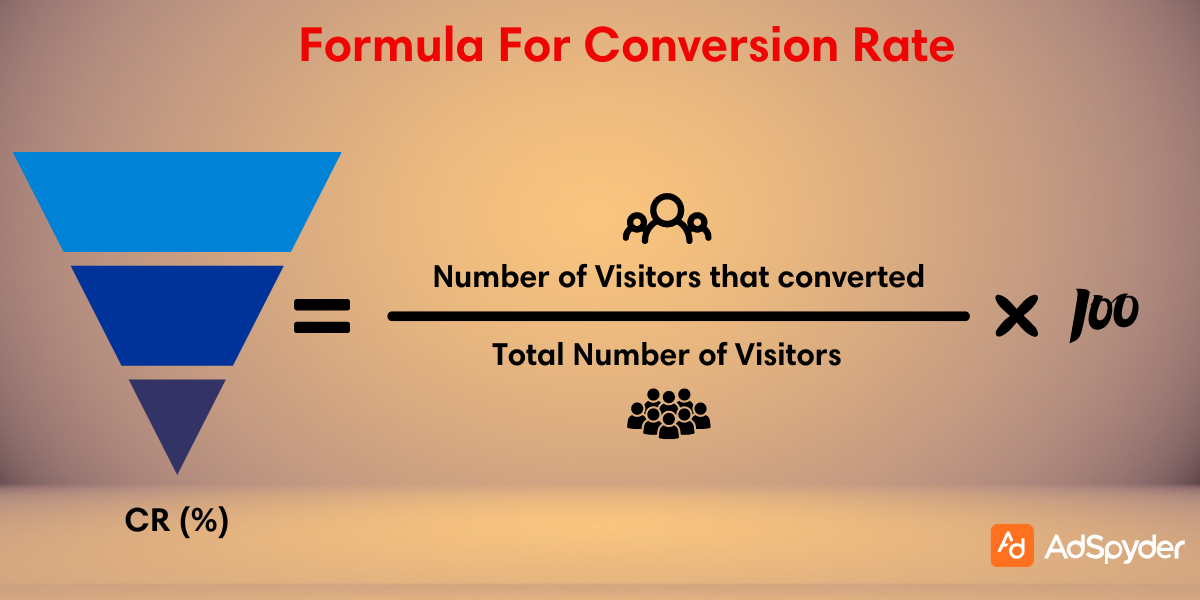
Conversion rate shows how often people do what you want after seeing your ad. It helps you understand if your Facebook ads work well.
Measuring Conversion Rate for Campaign Success
To measure the success of your Facebook ad campaigns, focus on the conversion rate. This shows how often clicks turn into desired actions, like sales or sign-ups. A high conversion rate means your ads are effective and target the right audience.
To improve it, tweak your ads based on what works best.
Enhancing Conversion Rates
Enhancing your conversion rates in Facebook ad campaigns requires a focused approach. It’s all about making more people take the action you want, like buying something or signing up.
- Optimize your landing pages: Make sure the page you send people to matches what your ad promises. Fast load times and easy navigation help too.
- Use strong calls to action: Tell viewers exactly what you want them to do with clear, compelling words.
- Target the right audience: Get your ads in front of people most likely to be interested in what you’re offering by using Facebook’s detailed targeting options.
- Test different ad formats: See which types of ads (like video or carousel) work best for your goal.
- Keep your message clear: Your ad should quickly tell someone why they should care about what you’re offering.
- Use high-quality visuals: Attractive images or videos can make people stop scrolling and look at your ad.
- Adjust based on analytics: Regularly check how your ads are doing and change things that aren’t working.
- Offer something valuable: Discounts or exclusive content can encourage clicks and conversions.
- Create a sense of urgency: Limited-time offers can make people act faster.
- Retarget interested users: Show ads again to people who interacted with your site but didn’t convert the first time.
Frequency: Measuring Ad Exposure
Frequency tells you how often people see your ads. Keeping frequency at the right level helps avoid annoying your audience.
Understanding Frequency in Ad Campaigns
Understanding frequency in Facebook ad campaigns means knowing how often people see your ads. If you show your ad too much, people might get annoyed. Not enough, and they might forget about you.
The goal is to find a sweet spot where your audience sees your ad just the right number of times to take action without feeling overwhelmed.
Moving on, let’s explore balancing frequency for optimal exposure in the next section.
Balancing Frequency for Optimal Exposure
You need to find the right balance in how often people see your ads on Facebook. Too much or too little can affect your ad campaign’s success. Here are tips to help you balance frequency for optimal exposure:
- Set clear goals: Know what you want from your ad campaign. This helps decide how often to show your ads.
- Use targeting wisely: Target the right audience. This makes sure your ads reach people interested in what you’re offering.
- Monitor frequency score: Check your ad frequency regularly in Facebook Ads Manager. A high number might mean people are seeing your ads too often.
- Test different frequencies: Try showing your ads more or less often and see what works best.
- Adjust based on performance: If you notice a drop in engagement, it might be time to show your ad less often.
- Keep content fresh: Change your ad content regularly so it stays interesting even if seen multiple times.
- Consider ad timing: Show your ads at times when your audience is most likely online for better results.
Finding the perfect frequency helps avoid annoying potential customers while ensuring they remember your message.
Quality Ranking

Quality Ranking shows how your ad compares to others targeting the same audience. Improve your ranking by making ads more relevant and engaging.
Deciphering Facebook’s Quality Ranking
- Facebook’s Quality Ranking tells you how your ad measures up against others targeting the same audience.
- Think of it as Facebook’s way of saying which ads offer more value. A high ranking means your ad is relevant and engaging to viewers.
- To improve this score, focus on creating content that resonates with your audience. Use clear images, write compelling copy, and make sure your message is spot on.
- Ads with higher quality rankings cost less to deliver and get better placement, making them more likely to be seen by potential customers.
- Keep track of this metric and always aim for improvement by testing different strategies to see what works best for connecting with your target market.
Improving Quality Ranking for Better Performance
After learning how to understand Facebook’s Quality Ranking, it’s time to make yours better. Here are steps to do just that:
- Create engaging content. Posts and ads that get lots of likes, shares, and comments will improve your ranking.
- Use high – quality images and videos. Clear and compelling visuals grab attention more effectively.
- Write clear, interesting ad copy. Make sure your text is easy to read and speaks directly to your audience’s interests.
- Target your ads carefully. Aim for people most likely to find your ad relevant by narrowing down your audience.
- Test different ad formats. See which ones your audience engages with the most by trying out various types of ads.
- Keep your messaging consistent but fresh. Regularly update your ads while keeping them recognizable to your brand.
- Respond quickly to comments on your ads. Active responses show you value customer feedback, improving engagement.
- Monitor ad performance closely. Adjust the poorly performing ones promptly based on the analytics.
- Encourage user – generated content related to your brand or products—share stories or photos submitted by happy customers.
- Follow Facebook’s ad guidelines strictly to avoid having ads rejected or penalized.
Taking these actions can lead you towards not only better quality rankings but also enhanced overall campaign success on Facebook ads.
Page Engagement Tracking
Keep an eye on how people interact with your Facebook page. Use this data to make your posts more engaging. Having this feedback mechanism helps advertisers to maximise their returns on Faebook ad campaigns.
Overall Engagement on Your Facebook Page
- Tracking the overall engagement on your Facebook page is key to understanding how well your content connects with your audience.
- This means looking at likes, comments, shares, and even how many people click on your posts.
- High engagement means your audience finds your content valuable and interesting. To boost this interaction, post regularly and make sure what you share resonates with what they care about.
Strategies to Increase Page Engagement
Page engagement turns your Facebook page into a lively community. It makes your content visible to more people.
- Post regularly: Keep your page fresh with new content. This encourages visitors to check back often.
- Use high-quality images and videos: Visuals capture attention faster than text alone. Make sure they are clear and relevant.
- Ask questions: Start conversations by asking your audience their thoughts. This invites comments and interaction.
- Hold contests and giveaways: These can drive immediate engagement from people who want to win something.
- Share user-generated content: When followers create content related to your brand, share it. This makes them feel valued and encourages others to do the same.
- Respond to comments quickly: Show that you value feedback by replying promptly. This builds a positive community feeling.
- Use Facebook Stories: These short, engaging clips can attract viewers who prefer quick content.
Watch out: E-commerce vs Dropshipping | Advantages and Disadvantages
Video View Metrics
Video view metrics show how well your Facebook video ads perform. They help you see who watches your videos and for how long, guiding better content choices.
Analyzing Video Performance in Facebook Ads
- To make your Facebook video ads work harder, keep a close eye on how they perform. Look at metrics like view count to understand how many people watch your videos. Also, check the average watch time to see how long they stay engaged.
- This tells you if your content captures interest.
- Watch rates and engagement levels reveal what works in your videos and what doesn’t. Use this insight to tweak your strategy and create more compelling content that keeps viewers watching longer.
- Focus on telling stories that resonate with your audience for higher performance in future campaigns.
Leveraging Video Content for Higher Engagement
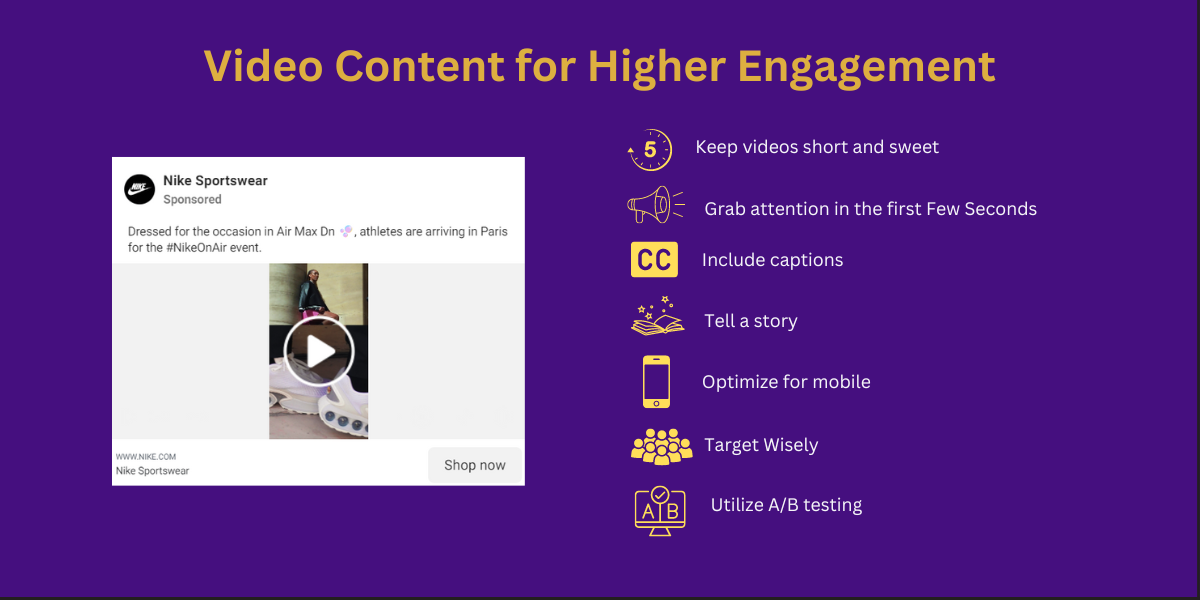
Videos capture attention on Facebook, making them a key tool for boosting interaction with your ads. They offer a dynamic way to share your message and connect with your audience. Here’s how you can use video content for higher engagement:
- Keep videos short and sweet: Aim for 15 – 30 seconds to maintain viewer interest.
- Start strong: Grab attention in the first 3 seconds with compelling visuals or an intriguing start.
- Include captions: Many people watch videos without sound, so text helps convey your message.
- Tell a story: Create a narrative that viewers can follow, making the video more memorable.
- Use high – quality visuals: Clear, crisp images and smooth video make your ad look professional.
- Optimize for mobile viewing: Ensure videos look good on smaller screens since most users are on mobile devices.
- End with a clear call-to-action (CTA): Tell viewers what you want them to do after watching the video, like visiting a website or making a purchase.
- Test different formats: Try various types of videos such as animations, customer testimonials, or behind-the-scenes peeks to see what resonates with your audience.
- Target wisely: Use Facebook’s targeting features to show your video to the right people who are more likely to engage with it.
- Monitor and adjust: Keep an eye on how your videos perform and tweak based on metrics like view time and engagement rate.
By focusing on these strategies, you can make the most of video content in Facebook ads to draw more viewers, keep their interest longer, and encourage them to act on your message.
Bonus: Advanced Metrics for Long-Term Campaign Success
To ensure sustainable Facebook ad campaign growth, it’s crucial to track metrics beyond short-term performance, focusing on long-term impact and customer retention.
- Customer Lifetime Value (CLTV): CLTV helps measure the total revenue a customer will generate throughout their relationship with your brand. By analyzing this, advertisers can optimize ads that target high-value customers, adjusting bids to focus on audiences with the highest potential ROI.
- Return on Ad Spend (ROAS) by Lifecycle Stage: Segment ROAS by customer lifecycle stages (e.g., new customers, returning customers) to identify which campaigns nurture long-term engagement. This enables better budget allocation towards acquiring and retaining high-value users.
- View-Through Conversions (VTC): VTC tracks users who see your ad but don’t immediately interact, yet convert later. This metric is essential for understanding how branding and awareness campaigns contribute to long-term conversions, even without direct clicks.
- Ad Frequency and Audience Saturation: Monitoring ad frequency ensures that your audience isn’t overexposed to the same ads. This would usually lead to ad fatigue. By managing audience saturation, you can maintain a healthy balance between engagement and relevance over time.
- Churn Rate and Retention Metrics: For subscription or repeat-purchase businesses, tracking churn rate (the percentage of customers who stop engaging with your product or service) is essential. Ads should be optimized to target users most likely to stick around and prevent churn, while retention metrics show the effectiveness of remarketing campaigns in keeping existing customers engaged.
Advanced metrics like CLTV, ROAS by lifecycle stage, and VTC offer insights into long-term success, enabling advertisers to refine their strategies for sustainable growth. By understanding and optimizing for long-term performance, campaigns can drive lasting customer relationships and maximize lifetime profitability.
Custom Metrics for Specific Campaign Goals
To achieve more precise insights, it’s important to create custom metrics for Facebook ad campaign goals, whether it’s lead generation, app installs, or brand awareness.
- Lead Quality Score: For lead generation campaigns, beyond just tracking leads, focus on the quality of leads by assigning a custom metric that measures post-lead actions like newsletter sign-ups or demo requests. This helps gauge the true value of generated leads. This metric is quite handy in SaaS and real estate advertising.
- Cost Per Qualified Lead (CPQL): While Cost Per Lead (CPL) is a standard metric, CPQL offers deeper insights by focusing on leads that meet predefined criteria (e.g., higher engagement or purchase intent), ensuring campaigns are bringing in high-value prospects.
- Install-to-Action Rate (for App Campaigns): Instead of just tracking app installs, measure the Install-to-Action Rate—the percentage of users who perform a key action within the app (e.g., sign-ups, purchases) after installing. This helps refine campaigns to attract users who install and engage meaningfully with the app.
- Ad Recall Lift Rate: In branding campaigns, measure how many users remember seeing your ad through Ad Recall Lift. It estimates the likelihood that people will recall your ad, which is critical for campaigns focused on increasing brand awareness rather than direct conversions.
- Return on Objective (ROO): For businesses with non-transactional goals (e.g., webinar sign-ups or content downloads), ROO measures the efficiency of achieving those specific goals, providing a clearer picture of success.
- Conversion Value by Campaign Type: Custom metrics that track conversion value segmented by campaign type help advertisers allocate budgets more effectively, prioritizing campaigns with the highest return on conversion goals.
FAQs
Conversion Rate is key, as it measures how effectively your ads are turning clicks into actions like purchases or sign-ups.
Custom metrics are tailored KPIs that align with specific campaign goals, such as lead quality or engagement rate by post type.
Use a custom Lead Quality Score metric to track post-lead actions like sign-ups or demo requests, indicating the value of your leads.
Ad Recall Lift measures how likely people are to remember seeing your ad, crucial for brand awareness campaigns.
The Install-to-Action Rate metric helps measure how many users perform key actions within the app after downloading it.
CPQL focuses on leads that meet specific quality criteria, helping you attract high-value prospects instead of just high volume.
Return on Objective (ROO) tracks the efficiency of achieving non-revenue goals like sign-ups or downloads, providing a clearer success measure.
Conclusion
Mastering Facebook Ad Campaigns means keeping an eye on key metrics. These 10 essential metrics show you where your ads shine and where they need work. Understand them well to boost your campaign’s success.
Your efforts in tracking and improving these areas will pave the way for better performance and higher engagement in your Facebook advertising strategy. Keep learning, keep optimizing, and watch your campaigns thrive.
